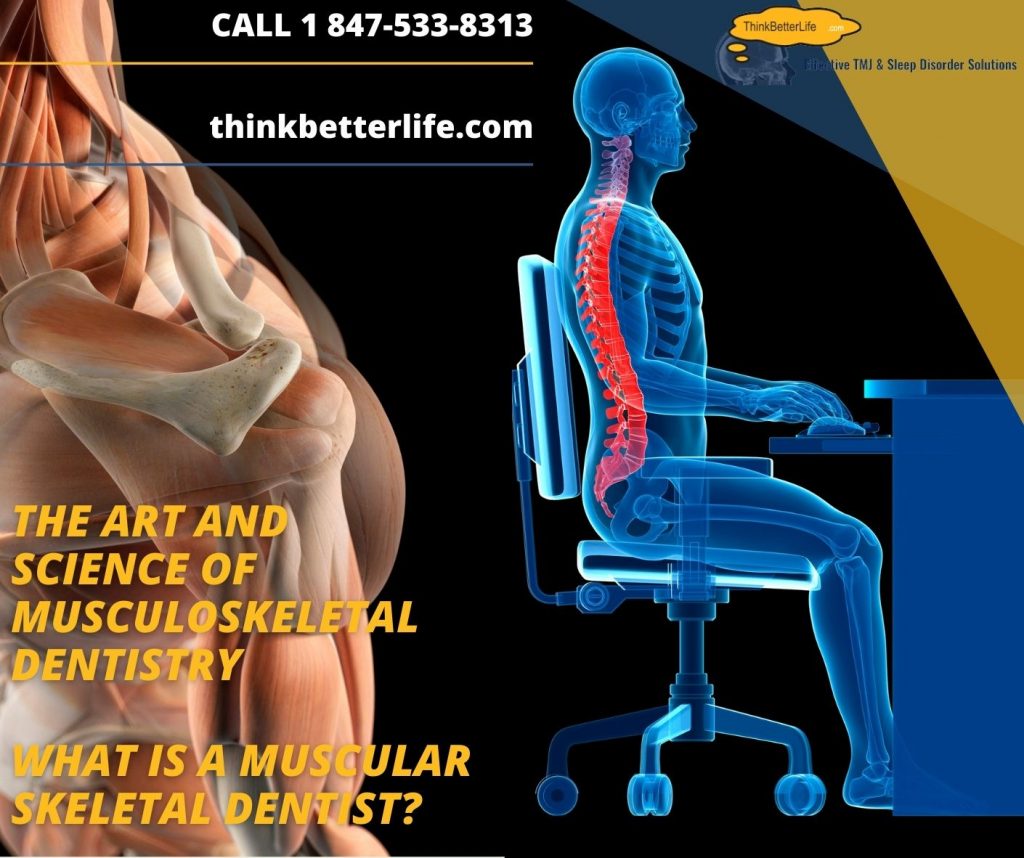Myofascial Pain and Dysfunction the most common cause of pain is best addressed utilizing Musculoskeletal Dentistry to correct functional and physiologic issues that can cause TMJ Disorders (TMD), Headaches, Migraines, Neck and Shoulder Pain, Forward Head Posture and whole body effects related to head and jaw function.
Neuromuscular Dentistry (often called Physiologic Dentistry) is a powerful diagnostic and treatment tool used by dentists to address TMD disorders and their sequelae.
 Dentistry is often thought to only about the treatment diseases of the teeth and gums. While keeping the mouth healthy is vitally important it is only the tip of the iceberg.
Dentistry is often thought to only about the treatment diseases of the teeth and gums. While keeping the mouth healthy is vitally important it is only the tip of the iceberg.
Orthodontics is the science of moving the teeth thru the bone primarily for esthetics but it also affects function. Some orthodontists combine orthopedics with the movement of teeth.
The orthopedics of the head, Jaw and neck is vitally important to the health of patients. It determines how the muscles function for talking, eating and breathing. The relation of the cranium to the lower jaw or mandible, hyoid bone and the rest of the body is a major determinant of whole body posture.
The orthopedics also determine the health of the nasopharyngeal airway which determines brain and neurologic development in children. This can affect children’s entire life and can determine issues like ADD, ADHD, Behavioral Disorders, Growth and Development.
Neuromuscular approach of treatment begins with a Neuromuscular Diagnostic Orthotic to correct the relation of the mandible to the maxilla by correcting mandibular function. The relationship of the cranium to the mandible is one link of a complex musculoskeletal postural chain. The hyoid bone is another important link in this chain. The hyoid bone is the only bone in the human body that does not connect to any other bones. It does have muscular and fascial connections to the skull, the mandible, the pharynx, and to rest of the body via the infrahyoid muscles. The tongue is an amazing muscular organ that has multiple hard wired reflexes to maintain airway and posture while allowing speech and maintaining the nasopharyngeal airway.
An excellent paper on Tongue reflexes by A J Miller is “ORAL AND PHARYNGEAL REFLEXES IN THE MAMMALIAN NERVOUS SYSTEM: THEIR DIVERSE RANGE IN COMPLEXITY AND THE PIVOTAL ROLE OF THE TONGUE”
https://journals.sagepub.com/doi/full/10.1177/154411130201300505
The single most important function is Life and maintaining an airway to support it.
Form follows Function and function reflects form are basic medical and anatomical truths. This anterior postural chain is highly influenced by masticatory muscles controlled by the
Trigeminal Nerve. The Maxillary Division is the major sensory input and the Mandibular Division controls the musculature.
Muscles adapt to protect posture, balance and airway. When muscle must exhibit excessive function, shortening, splinting, spasm to protect the bodies integrity they sacrifice their health and develop taut bands and trigger points as described by Dr Janet Travell.and the development of myofascial Pain and Dysfunction develops. Taut band and trigger points in the muscles can cause referred pain often to distant areas and often result in new trigger points forming in distant muscles.
This anterior postural chain is highly sensitive tp proprioceptive input from all oral structures. The posterior postural chain (Head, neck, shoulders, spine, hips down to feet) has much less input into the CNS (central nervous system).
Sherrington described in his Nobel Prize winning research the righting reflex that explains how these postural changes are part of an important reflex: The Righting Reflex. Norman Thomas BDS, PhD explained these concepts to me but they can also be found in the work of Dr Janet Travell and are the subject of a research project I am currently working on with Dr Jennifer Hobson who was trained and lectures with Mariano Rocobado, the world renown expert in TMD Physical Therapy.
There are three main reset points in the body. The mouth during a swallow, the hips when sitting and the feet when standing. The Cranium /Atlas /Axis is a secondary set point to posture. All three of these set points are important to the work of Sherrington and total body balance.

